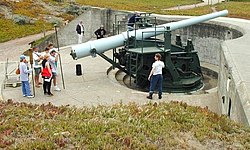History
Fort Kearny was built under the Endicott Program 1904-1908 as part of the Coast Defenses of Narragansett Bay. The fort is named for Major General Philip Kearny, killed in the American Civil War. It protected the West Passage of Narragansett Bay, along with Fort Getty in Jamestown and Fort Greble on Dutch Island. [1] [2] The fort was primarily armed with six 6-inch M1905 guns (152 mm) on disappearing carriages, four in Battery French and two in Battery Cram. Two 3-inch M1903 guns (76 mm) were also present in Battery Armistead. Battery French was named for William H. French, a general in the Civil War. Battery Cram was named for Thomas J. Cram, a topographical engineer in the Civil War. Battery Armistead was named for Captain Lewis G. A. Armistead, who was killed in the War of 1812.
The guns of Battery French were removed in 1917 for potential service on the Western Front; three of the guns were sent to France for use on field carriages, but sources indicate that none of the 6-inch gun regiments completed training before the Armistice and thus they did not see combat. [1] [3] The guns were not returned to Fort Kearny.
In World War II a large-scale modernization of coast defenses was implemented; in Narragansett Bay this was centered on Fort Church and Fort Greene. Fort Kearny was slated for disarmament once the new defenses were completed. In 1942 the 3-inch guns of Battery Armistead were relocated to Fort Varnum, and in 1943, with improved defenses completed, Fort Kearny's two remaining guns at Battery Cram were scrapped. [1] [2]
Fort Kearny was a prisoner-of-war camp in World War II, beginning in February 1945. [4] It was the headquarters of a program to re-educate German prisoners with democratic values, one element of which was the German-language newspaper Der Ruf (The Call) . [5] [6]
This page is based on this
Wikipedia article Text is available under the
CC BY-SA 4.0 license; additional terms may apply.
Images, videos and audio are available under their respective licenses.

